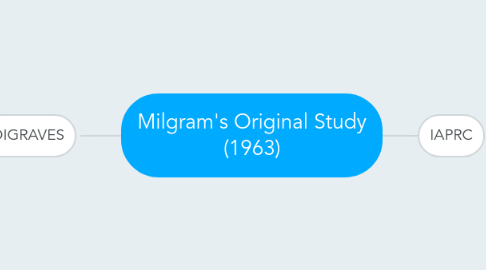
1. DIGRAVES
1.1. Demand Characteristics
1.1.1. Very Unlikely
1.1.1.1. Participants were deceived, believing they were participating in a study to investigate human learning, not obedience
1.2. Issues
1.2.1. Ethnocentric
1.2.1.1. Only conducted in America
1.2.2. Reductionist
1.2.2.1. Does not consider other factors that could be involved in obedience
1.2.2.1.1. Although, this is later addressed with his variations of the experiment
1.3. Generalisabiltity
1.3.1. Only conducted using Americans
1.3.1.1. Only generalizable to western cultures
1.3.2. Other studies from different cultures/places suggest that obedience is not culture specific
1.4. Reliability
1.4.1. High internal reliability
1.4.1.1. Experiment easy to replicate
1.4.1.2. It is standardised
1.4.1.3. Laboratory experiment
1.4.1.3.1. Variables controlled
1.5. Application
1.5.1. Led to the development of the Agency Theory
1.5.2. Helped to show that Germans were normal and that most in the situation of the Holocaust would have done the same
1.6. Validity
1.6.1. Low ecological validity
1.6.1.1. Laboratory experiment at Yale University
1.6.1.1.1. Artificial setting
1.7. Ethics
1.7.1. Study was optional
1.7.1.1. Their consent was given
1.7.1.1.1. But it was not fully informed due to decpetion
1.7.2. Right to withdraw
1.7.2.1. Despite having been told that they could withdraw at any time, the verbal prods suggested otherwise
1.7.2.1.1. They were paid, making them feel an obligation to fulfil their task
1.7.3. Deception
1.7.3.1. Told the shocks were real
1.7.3.2. Told the experiment was to investigate human learning, not obedience
1.7.4. Psychological Harm
1.7.4.1. Follow up one year later indicated that most were pleased to have taken part although one man regretted doing so
1.7.4.2. Although Milgram did not expect to see the distress that was shown by the participants, he should have stopped the experiment when he saw that this was the case
1.8. Studies
1.8.1. Supporting research
1.8.1.1. Burger (2009), a more ethical replication of Milgram's experiment
1.8.1.2. Several other studies in different cultures found similar results
1.8.2. No opposing research
2. IAPRC
2.1. Identification
2.1.1. First study conducted by Milgram in 1963
2.2. Aim
2.2.1. To investigate whether people would obey a perceived authority figure to test ‘are Germans different’ hypothesis
2.3. Procedure
2.3.1. Milgram advertised for participants to take part in a human learning experiment
2.3.2. One participant was the teacher and the other (a confederate) was the learner who was attached to a shock machine in a different room to the teacher's control desk. The teacher was given a test shock of 45V.
2.3.3. The teacher had to read out word pairs to the learner who had to learn them. The first word would be said followed by a choice of 4 words, one of which the learner had to choose.
2.3.4. If correct, the test would continue. If not, the teacher was required to give a shock to the learner (shock intensity increased by 15V each time).
2.3.5. The answers were all pre-recorded
2.3.6. At 300V, the learner began to protest, complaining of a heart condition. At 315V, the learner stopped responding to the questions. The teacher was instructed to treat this as 'wrong' and continue to shock the learner
2.3.7. If the teacher wanted to stop, the experimenter used verbal prods to encourage them to continue. If, after they were all said, the teacher still resisted, then the experiment was stopped
2.3.7.1. Please continue
2.3.7.2. The experiment requires that you continue
2.3.7.3. It is absolutely essential that you continue
2.3.7.4. You have no other choice - you must go on
2.3.8. The participants were debriefed and met with the learner to show he was not harmed
2.4. Results
2.4.1. 26 of 40 men continued to the end of the study (65%)
2.4.2. Many participants showed signs of nervousness, such as sweating, trembling, groaning, digging fingernails into their flesh and laughing/smiling
2.5. Conclusion
2.5.1. The instructions given by an authority figure were hugely influential and participants continued to administer shocks even when they became distressed about the wellbeing of the learner.
2.5.2. Social Influence is sting and people obey orders even when this causes them distress. The results were surprising - it was predicted that only 4% would continue to the end of the study
